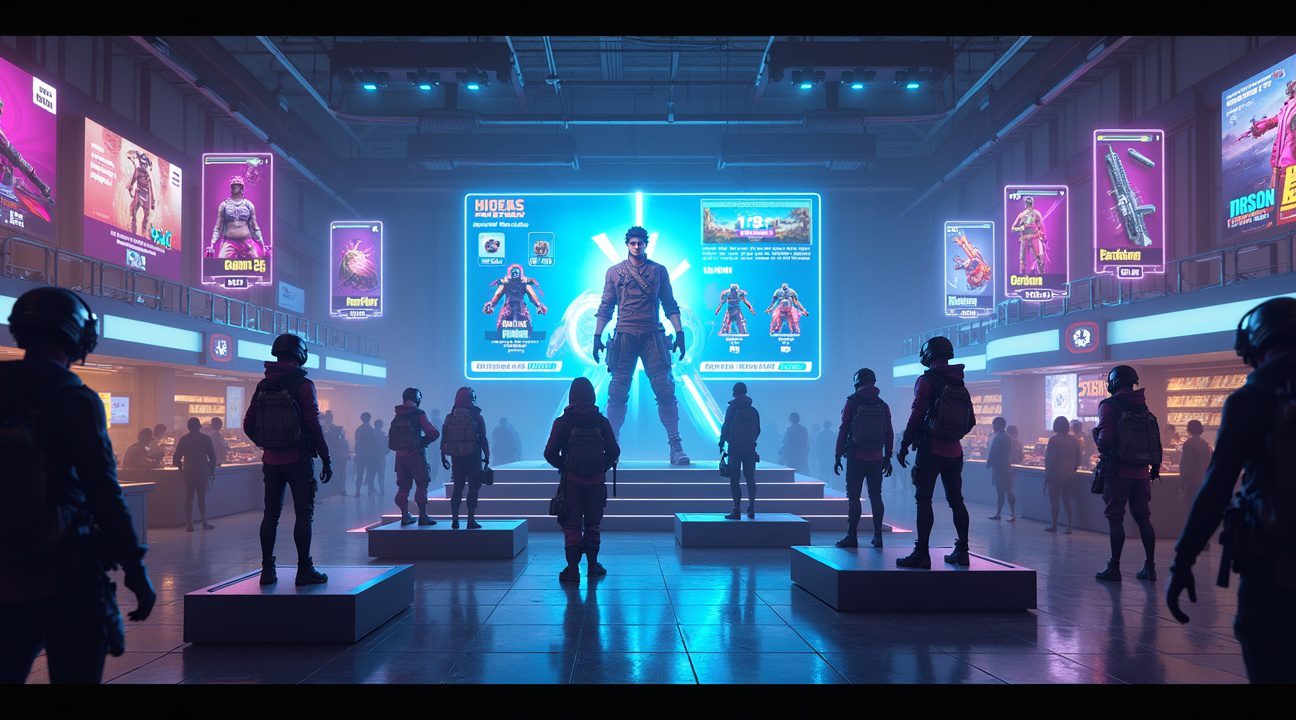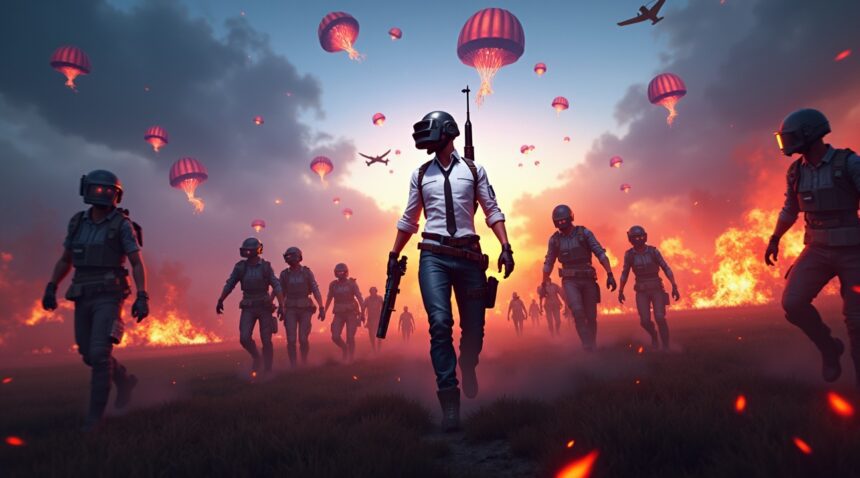PUBG on PC maintains its impressive 702,000 peak concurrent players through a comprehensive retention strategy that combines regular content updates, psychological engagement tactics, and community-building features.
The game’s sustained growth from 164,000 players in 2023 to over 309,000 average players in 2025 highlights how strategic development choices and social mechanics can reinvigorate established titles in the competitive battle royale market.
Key Takeaways
- Strategic content releases and limited-time events create urgency through FOMO psychology while delivering fresh gameplay experiences that drive consistent player return rates.
- Battle Pass systems with daily and weekly missions establish effective progression loops that encourage regular engagement through achievable goals and escalating rewards.
- Cosmetic customization and VIP treatment systems utilize personalization and status recognition to foster emotional investment and incentivize spending among committed players.
- Team-based gameplay and social features help build enduring communities via voice chat integration, clan systems, and cooperative mechanics that connect players beyond a single game session.
- Regional tournaments and localized content sustain global appeal by offering culturally specific engagement strategies, which enhance participation and increase per-user revenue in key markets.
To experience how PUBG enables this immersive, community-driven momentum firsthand, visit the official PUBG website.
PUBG PC Player Count Surge: 702,000 Peak Concurrent Users Signal Massive Resurgence
PUBG’s recent player count statistics reveal a remarkable comeback story that defies industry expectations. The game averaged 309,000 players in June 2025, demonstrating substantial growth from the 287,000 recorded in 2024 and a dramatic leap from the 164,000 players in 2023. This upward trajectory marks one of the most significant revivals in battle royale gaming history.
July 2025 delivered an even more impressive milestone when PUBG reached a staggering peak of over 702,796 concurrent players. This figure represents one of the highest concurrent user counts the game has achieved in recent years, signaling that the battle royale format still commands massive appeal among PC gamers. Players remained engaged throughout extended gaming sessions, with Steam charts showing sustained activity well beyond typical peak hours.
The year-over-year statistics paint a compelling picture of growth that extends beyond simple seasonal fluctuations. Monthly active users have shown consistent increases, while daily active users demonstrate improved retention patterns that suggest players aren’t just trying the game briefly but committing to longer-term engagement. This data contradicts predictions about the genre’s decline and highlights PUBG’s ability to adapt and evolve.
Factors Driving the Resurgence
Several key elements have contributed to this impressive player count recovery:
- Major content updates coinciding with engagement spikes
- New map releases and weapon balance adjustments
- Seasonal events and competitive tournaments
- Tactical gameplay that differentiates PUBG from faster-paced rivals
- Technical improvements leading to greater accessibility
Strategic development choices have made a clear impact. I’ve observed that players kept active in PUBG respond particularly well to regular updates and gameplay expansions.
Seasonal events and competitive tournaments have also played crucial roles in maintaining momentum. These initiatives create concentrated periods of heightened activity that often translate into sustained player growth. The retention rate improvements suggest that new players acquired during these events continue playing long after promotional periods end.
Competition from other battle royale titles hasn’t diminished PUBG’s appeal as much as analysts predicted. Instead, the game has carved out a distinct identity that appeals to players seeking more tactical gameplay compared to faster-paced alternatives. This positioning has helped maintain a dedicated player base while attracting newcomers who prefer PUBG’s unique approach to the genre.
The gaming community’s renewed interest reflects broader trends in how video games impact individuals and social interaction patterns. PUBG’s team-based mechanics and communication requirements have strengthened its appeal among players looking for meaningful multiplayer experiences.
Technical improvements have also contributed significantly to player satisfaction. Server stability enhancements and performance optimizations have addressed many longtime complaints, making the game more accessible to players with varying hardware capabilities. These infrastructure investments have paid dividends in terms of player retention and positive word-of-mouth recommendations.
The concurrent player peak of 702,796 users represents more than just statistical success—it demonstrates PUBG’s resilience in a highly competitive market. Steam charts data shows that this peak wasn’t an isolated spike but part of a sustained period of elevated activity spanning several weeks. Daily fluctuations remained well above historical averages, indicating that the surge represented genuine renewed interest rather than temporary promotional effects.
Looking at broader gaming trends, PUBG’s resurgence occurs alongside discussions about video games solving real problems and their cultural significance. The game’s emphasis on strategic thinking and team coordination positions it well within these evolving conversations about gaming’s value beyond entertainment.
The 702,000 concurrent user milestone serves as clear evidence that PUBG has successfully reinvented itself for a new era of battle royale gaming. This achievement demonstrates that established titles can reclaim prominence through focused development efforts and community engagement strategies.
How Content Updates and Live Events Drive Player Retention Spikes
PUBG maintains its massive player base through a calculated approach to content releases and live events that consistently reignite player interest. The game’s developers understand that players are kept active through strategic content drops that create buzz and excitement within the community. Major patches introducing new maps, weapon systems, or core gameplay mechanics generate immediate and measurable increases in concurrent player counts across PC platforms.
Strategic Content Releases Create Significant Player Surges
Each substantial update functions as a catalyst for renewed engagement, with new maps typically producing the most dramatic player retention spikes. Map changes and weapon additions don’t just refresh the gameplay experience—they fundamentally alter strategies and force players to adapt their approaches. Cosmetic updates, while seemingly less impactful, actually contribute significantly to player retention by offering personalization options that keep players invested in their in-game identity.
Seasonal updates operate on predictable cycles that players anticipate, creating natural return points for lapsed users. These major content drops often coincide with holiday periods or significant gaming events, maximizing their visibility and impact. The psychological effect of fresh content cannot be understated; even minor tweaks to existing systems can make familiar gameplay feel entirely new.
Limited-Time Events Leverage Urgency Psychology
PUBG’s rotating game modes and limited-time events masterfully exploit FOMO (fear of missing out) psychology to drive consistent engagement. These temporary experiences offer exclusive rewards that become unavailable once events conclude, creating artificial scarcity that motivates immediate participation. The following elements make these events particularly effective at retention:
- Exclusive cosmetic rewards that showcase participation in special events
- Timed objectives that require multiple gaming sessions to complete
- Collaboration events featuring popular franchises or brands
- Special game modes that dramatically alter traditional PUBG mechanics
- Leaderboards and competitive elements specific to event periods
Live events create shared experiences that strengthen community bonds while simultaneously driving individual player engagement. Players return not just for the rewards, but for the social aspect of participating in time-sensitive community moments. This approach transforms video games into positive forces that build lasting connections between players.
The combination of predictable seasonal content and unpredictable limited-time events creates a retention ecosystem where players always have something to anticipate. This dual approach ensures that PUBG remains relevant in an increasingly competitive battle royale market, with each update serving as both a retention tool for existing players and an acquisition mechanism for new ones.
Battle Pass Systems and Progression Mechanics That Keep Players Coming Back
Battle Pass systems have transformed how PUBG maintains its player base by creating compelling progression loops that keep users engaged long after their first match. These systems work by establishing clear, achievable goals that provide players with constant motivation to return to Battlegrounds.
Daily and Weekly Mission Structures
PUBG’s mission system creates multiple engagement touchpoints throughout each week by offering varied objectives that cater to different playstyles. Players can tackle challenges ranging from weapon-specific eliminations to survival milestones, ensuring that both aggressive and tactical players find relevant goals. These missions refresh regularly, preventing the gameplay from becoming stagnant while encouraging players to experiment with different strategies and loadouts.
The weekly mission rotation introduces higher-stakes objectives that require sustained effort over several days. This approach creates a commitment loop where players feel compelled to log in consistently rather than taking extended breaks. XP rewards from these missions contribute directly to Battle Pass advancement, creating a tangible sense of progress with each completed objective.
Seasonal rank resets add another layer of motivation by giving players fresh starts and new mountains to climb. When ranks reset, even veteran players must work their way back up the competitive ladder, creating renewed engagement opportunities. This system prevents stagnation among high-level players while giving newer players periodic chances to compete on more even ground.
Login bonuses function as gentle nudges that discourage player inactivity through progressive reward structures. Players who maintain daily login streaks receive increasingly valuable rewards, from basic currency to exclusive cosmetic items. Missing even a single day breaks the streak, creating a psychological pressure to maintain consistency. This mechanism proves particularly effective because the rewards scale upward, making each subsequent day’s login more valuable than the last.
The progression system extends beyond mere cosmetics to include functional rewards that enhance the gameplay experience. Weapon skins, character outfits, and emotes provide visual progression markers that other players can observe, satisfying the human desire for status display within the gaming community.
Research on player retention shows that games with structured progression systems experience significantly higher Day 1 and Day 30 retention rates compared to those without such mechanics. PUBG leverages this principle by ensuring that progress feels meaningful and achievable, even for casual players who can’t dedicate hours daily to the game.
These retention strategies work together to create a comprehensive engagement ecosystem. By combining short-term daily objectives with long-term seasonal goals, PUBG maintains player interest across different time horizons. This multi-layered approach ensures that players always have both immediate and distant targets to pursue, creating a persistent motivation to return to the battlefield.
Cosmetic Customization and FOMO-Driven Monetization Strategies
I’ve observed how PUBG on PC masterfully leverages cosmetic customization to maintain player engagement through sophisticated psychological triggers. The game’s extensive catalog of skins, outfits, and weapon styles creates an irresistible appeal that keeps players returning. Regular refreshes of the in-game shop and loot crate systems ensure fresh content appears consistently, preventing staleness that might drive players away.
Limited-time exclusives form the backbone of PUBG’s retention strategy. Fear of missing out strikes particularly hard when rare cosmetic items disappear forever after brief availability windows. Players develop anxiety about potentially missing exclusive content, which directly translates into higher return rates and sustained engagement periods.
VIP Systems and Personalized Player Treatment
The personalization extends far beyond surface-level customization options. PUBG analyzes individual playstyles and historical engagement patterns to deliver content recommendations that feel specifically crafted for each player. Custom avatars and weapon configurations adapt to preferences, creating deeper emotional investment in the game experience.
VIP systems recognize the most active and high-spending users through carefully designed reward structures:
- Exclusive cosmetic items unavailable through standard progression
- Personalized events with unique challenges and rewards
- Early access to new content before general release
- Prioritized customer support with faster response times
- Special recognition badges and status symbols
High-value players, often termed “whales” in the industry, receive particular attention through these premium treatment systems. Their substantial financial contributions unlock progressively exclusive benefits that maintain their elevated status within the community. These players become walking advertisements for premium content, inspiring others to increase their own spending levels.
The psychological impact of cosmetic upgrades reaches beyond simple aesthetics. Players develop emotional attachments to their customized appearances, creating sunk cost fallacies that make leaving the game feel like abandoning valuable investments. Gaming experiences become deeply personal when players see their unique style reflected in their characters.
Loot crates introduce gambling-like mechanics that trigger dopamine responses through unpredictable reward schedules. Opening crates becomes addictive as players chase rare items with extremely low drop rates. The anticipation and excitement of potential rewards often outweigh the actual value of items received.
PUBG’s monetization strategy brilliantly balances free content with premium offerings, ensuring non-paying players still feel included while creating clear incentives for financial investment. Limited-time events frequently offer pathways to exclusive items through both gameplay achievements and direct purchases, catering to different player preferences and spending capabilities.

Social Features and Team-Based Play That Build Lasting Communities
I’ve observed how PUBG’s social architecture transforms individual players into dedicated community members through carefully designed cooperative systems. The game’s squad and duo formats create natural bonding experiences where players must communicate, strategize, and depend on each other for survival. These high-stakes collaborative moments forge stronger connections than typical social gaming features.
Voice chat integration serves as the backbone of these relationships, enabling real-time coordination that extends far beyond tactical callouts. Players naturally develop inside jokes, celebrate victories together, and support each other through defeats. These shared experiences create emotional investments that keep players active long after their individual interest might have waned.
Building Networks Through Strategic Social Systems
Custom matches unlock even deeper community engagement by allowing groups to create private tournaments, training sessions, and experimental gameplay modes. Friend lists become more than contact databases—they transform into recruitment pools for reliable teammates. I notice that players often maintain extensive networks specifically for different game modes and skill levels.
Clan systems amplify these connections by providing formal structures for ongoing relationships. Members develop loyalty not just to individual friends but to group identities and reputations. The social pressure to participate in clan activities and maintain standing creates powerful retention mechanics that operate independently of core gameplay loops.
Data reveals that 20% of highly engaged players drive disproportionate engagement and monetization through their social connections. These influential community members act as anchors, drawing less active friends back into the game and introducing new players to established groups. Their spending patterns on cosmetics and battle passes often influence entire friend networks.
The cooperative nature of survival gameplay creates unique dependency relationships rarely found in other competitive genres. Unlike traditional team sports where individual skill can compensate for weak teammates, PUBG’s format demands genuine collaboration. Players quickly learn that consistent teams perform better than random matchmaking, creating strong incentives to maintain regular gaming partnerships.
These social bonds extend beyond gaming sessions through integrated communication features and external platforms. Groups coordinate schedules, discuss strategies, and share highlights, maintaining engagement even during offline periods. The game becomes a social hub rather than just entertainment, embedding itself into players’ daily communication routines.
The multiplayer engagement loop feeds on itself as successful teams attract new members while struggling groups motivate improvement efforts. Players invest time not just in personal skill development but in group dynamics and leadership capabilities. This creates multiple progression paths that appeal to different personality types and social preferences.
Regular events and challenges designed for team participation provide structured opportunities for groups to test their coordination and celebrate achievements together. These shared goals give established communities reasons to remain active while providing natural entry points for newcomers seeking social connections.
Regional Tournaments and Global Community Engagement Tactics
PUBG Corporation understands that global success requires local relevance, which drives their comprehensive regional engagement strategy. The developer strategically focuses on top-performing regions—Asia, North America, and Europe—by implementing customized content and events that resonate with local gaming cultures and preferences.
Strategic Regional Tournament Framework
National tournaments serve as the cornerstone of PUBG’s regional engagement approach. These competitions create multiple benefits that directly impact player retention:
- Increased visibility through region-specific streaming and coverage
- Local prize pools that attract competitive players from each territory
- Cultural relevance through partnerships with regional gaming organizations
- Enhanced ARPU by region through tournament-related cosmetic sales and battle passes
- Community building among players who share similar time zones and languages
The impact of these regional tournaments extends beyond the competitive scene. Data shows that areas hosting major PUBG tournaments experience significant spikes in both daily and monthly active users during and after events. This correlation demonstrates how esports tournaments function as powerful marketing tools that convert viewers into active players.
PUBG’s localization efforts complement their tournament strategy by ensuring that players are kept active through culturally relevant content. The game features region-specific skins, map themes, and seasonal events that reflect local holidays and traditions. These localization strategies create emotional connections between players and the game, fostering long-term loyalty that transcends simple gameplay mechanics.
Regional leaderboards add another layer of engagement by creating competitive hierarchies within specific geographic areas. Players can compare their performance against others in their region, which feels more achievable than competing on a global scale. This system encourages consistent play as users strive to maintain or improve their regional rankings.
The success of PUBG’s regional approach becomes evident when examining ARPU by region data. Areas with strong tournament presence and active localization efforts consistently show higher revenue per user compared to regions with minimal regional support. This financial performance validates the strategy of investing in region-specific content and events.
PUBG Corporation also leverages regional partnerships with local gaming cafes, streamers, and content creators to amplify their engagement efforts. These collaborations create authentic touchpoints between the game and local gaming communities, generating organic growth that feels genuine rather than manufactured.
The combination of competitive tournaments, localized content, and regional community building creates a sustainable engagement ecosystem. Players remain active because they feel part of a local gaming community while still participating in a global phenomenon, striking the perfect balance between local relevance and international competition.
Sources:
Udonis – PUBG Mobile Player Count & Revenue Stats
Game Design Skills – Player Retention Strategies
ExitLag – PUBG Steam Charts
Feature Upvote – Game Retention Strategies from Popular Games
Solsten – Long-Term Player Retention Strategies for 2024
OHEpic – PUBG 2025 Stats: Free to Play, 700K Peak Players, 112M MAU
Accio – PUBG Mobile Popularity Trend


